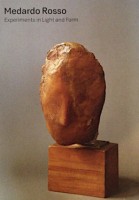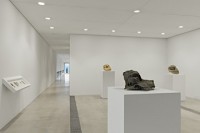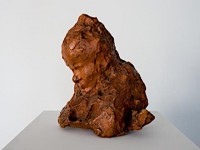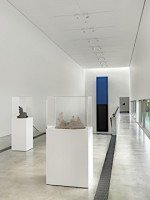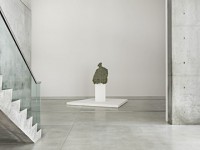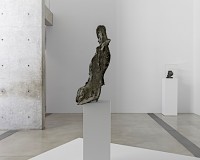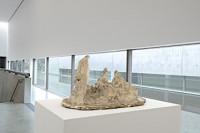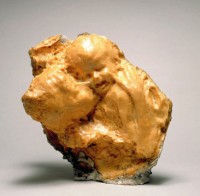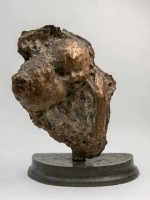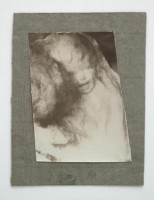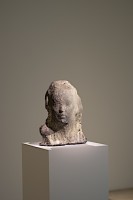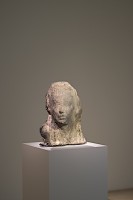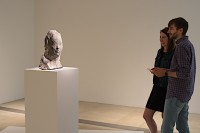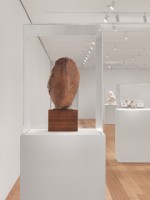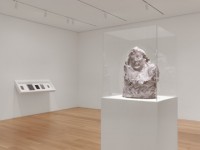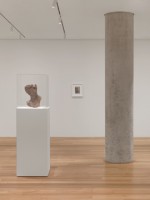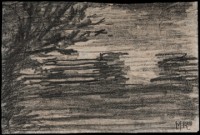The browser will either open the file, download it, or display a dialog.
Medardo Rosso: Experiments in Light and Form
Pulitzer Arts Foundation
St. Louis, Missouri
November 11, 2016 – May 13, 2017
Catalogue:
Medardo Rosso: Experiments in Light and Form.
Essays by Sharon Hecker and Tamara Schenkenberg.
St. Louis: Pulitzer Arts Foundation, 2017.
58 pp.; 32 color and 1 b&w illus.; checklist.
Free, $14.00 shipping and handling from museum website: http://pulitzerarts.org
ISBN: 978-0-9976901-3-2
It is a commonplace of art criticism that the sculpture of Medardo Rosso (1858–1928) is prized by artists and scholars—as well as collectors—but is largely unfamiliar to wider audiences. As with all clichés, this contains a certain truth. Like other sculptors of the period, during his lifetime Rosso was eclipsed by Auguste Rodin. Today his oeuvre—rarely included in survey texts of nineteenth-century art—is overshadowed by that of other contemporaries, such as Camille Claudel. Yet Rosso’s achievement is considered central to the development of the modernist sculpture of Umberto Boccioni, Constantin Brancusi, Alberto Giacometti, and others. Exhibitions of Rosso’s work seem to be haunted by his failure to achieve the canonical status that many feel his oeuvre warrants: Medardo Rosso: Experiments in Light and Form, organized by the Pulitzer Arts Foundation, made the case for the critical but under-recognized significance of Rosso’s radical experimental effort to couple the permanent materiality of sculpture and the ephemeral insubstantiality of light.
The exhibition, which highlighted work produced during Rosso’s decades in Paris, included 26 sculptures, 29 photographs, and 35 drawings, making it the largest in half a century to be presented in the United States. Relying on public and private collections in Italy, Germany, and the United States, it followed a series of important exhibitions in the first decade of the twentieth century that expanded Rosso scholarship and two more recent presentations of his work at the Center for Italian Modern Art and Peter Freeman Gallery in New York City.[1] The Pulitzer exhibition, which did not travel, thus offered an important opportunity to view Rosso’s work. It was curated by Sharon Hecker, an independent scholar whose monograph, A Moment’s Monument: Medardo Rosso and the International Origins of Modern Sculpture, was published by University of California Press in spring 2017, and Tamara Schenkenberg, Associate Curator of the Pulitzer Arts Foundation.[2]
Rosso is often pegged as an “impressionist sculptor.” The artist himself fostered the association as early as 1885 by titling a monumental plaster Impression d’omnibus (later destroyed), and the French critic Edmond Thiaudière reinforced the tag in 1886 when he reviewed the works Rosso exhibited at the Salon des Artistes Français.[3] The seemingly contradictory notion of impressionist sculpture was explored in more depth in 1901 by Edmond Claris, who solicited statements on the subject from a number of contemporary artists, including Rosso, Rodin, and others.[4] If the label is useful in calling attention to Rosso’s preoccupation with the reciprocal interplay of light and atmosphere, material and surface, it oversimplifies his project, obscuring the experiments with photography and sculptural processes that were central to his innovations. The curators of the Pulitzer exhibition, through the incorporation of photography, drawings, and the discerning selection of sculptural works, contribute to advancing the recognition of the range and significance of Rosso’s investigations.
The Pulitzer Arts Foundation proved to be well suited to an appraisal of Rosso’s interest in light. The minimalist building of concrete and glass designed by Japanese architect Tadao Ando opened in 2001 and, despite a recent expansion, retains an intimacy and modest scale appropriate to the anti-monumentality of Rosso’s sculpture. The windows of the main gallery face northwest and open onto a courtyard pool, allowing works to be viewed within the subtle and shimmering natural light reflected off the surface of the water. In keeping with the Pulitzer Arts Foundation’s customary installation practice, the wall texts that are routine in museum presentations were eliminated in order to prioritize visitors’ visual encounter with the objects themselves. The absence of explanatory labels contributed to an austerely spacious and serene installation in the tradition of the “white cube” analyzed by Brian O’Doherty.[5] The presentation demanded an unusual level of engagement from casual visitors, but those unfamiliar with the artist or his history were provided contextual information by free copies of a gallery plan and catalogue and by gallery attendants trained to respond to questions.
The catalogue introduces the questions and issues surrounding Rosso’s work through lavish color reproductions and four succinct essays by Hecker and Schenkenberg (fig. 1). Hecker presents a biography of the artist and an explanation of his technical experiments with casting processes, which he used for wax as well as bronze; Schenkenberg considers Rosso’s works on paper and the interconnections between the role of light in Ando’s gallery spaces and Rosso’s work. The publication includes a summary checklist, but no bibliography; a more comprehensive catalogue is planned for fall 2017 that will include additional essays by Hecker and Schenkenberg as well as commentary by Matthew S. Witkovsky, Richard and Ellen Sandor Chair and Curator of the Department of Photography at the Art Institute of Chicago, and Jodi Hauptman, Senior Curator of the Department of Drawings and Prints at the Museum of Modern Art.
The exhibition began, appropriately, by exploring two works Rosso modeled in Milan that are sometimes considered his “breakthrough” sculptures: Portinaia (Concierge) and Carne altrui (Flesh of Others) (fig. 2). Both are representative of the realist genre subjects that Rosso engaged at the beginning of his career, but forego a detailed delineation of the figures’ forms in favor of the broad handling more routinely associated with bozzetti than finished works. Portinaia, exhibited in a wax over plaster version, is a bust of the doorkeeper from Rosso’s studio (fig. 3). The woman’s face, tilted forward as though she is dozing off or concentrating on something in her lap, rises out of an amorphous mass of wax. Eight small photographic renderings of the sculpture, installed in a case nearby, suggested how Rosso’s sculptural investigations were furthered by his experiments with the camera: they employ a variety of angles, focal points, and lighting conditions and are precisely, if irregularly, cropped to impose distinct viewing perspectives.[6] In the same gallery three versions in three different media—bronze, wax, and plaster—of Carne altrui, which represents the face of a sleeping prostitute, demonstrated how Rosso extended his experiments into manipulations of the form and media of sculpture itself. By varying the material, adjusting the angle of the base, and cropping the works, Rosso directed the viewer’s encounter with the prostitute: in the wax and glazed plaster versions, which are lighter in tone, her face sinks into billowing forms that evoke bedclothes; in the bronze, in which the dark patina absorbs the light, much of the surrounding mass was removed to give the face more prominence. The three works are essentially reiterations of a single idea, but Rosso’s choice of material and manipulation of the surface, his adjustment of the angle of viewing, and the form itself transform each version into a unique work.
The catalogue checklist references the dates in which the subjects were first modeled, but does not indicate when Rosso produced specific versions. Most of the works were cast by Rosso himself, according to Hecker, but since he is infamous for having spent the years after 1906 re-casting and revising earlier sculptures rather than fashioning new forms, it would be illuminating to know when the specific versions in the exhibition were produced. Wax is the medium with which Rosso is most often associated, but a catalogue footnote indicates that he began casting wax only after 1895, so it may be concluded that the wax versions of Portinaia and Carne altrui included in the exhibition are later iterations of these subjects.[7] Hecker has argued elsewhere that Rosso’s late repetitions and revisions of earlier work did not mark a falling off but rather a continuation of his creative engagement, allowing him “to build up the self while refusing to be categorized, objectified, or contained.”[8] Although the problem of dating Rosso’s works is said to be challenging, given the gaps and contradictions that fill his archive, the final catalogue scheduled for the fall offers an opportunity to provide more complete accounts of the exhibited works.[9]
The selection of works in the museum’s main gallery, which runs parallel to the water court, highlighted sculptures fashioned after Rosso relocated to Paris in 1889, when he exhibited work in the Exposition Universelle (fig. 4). Rosso’s years in the French capital, where he remained for three decades, proved difficult. He exhibited at irregular intervals in several European capitals, but though he received attention from French critics, remained dependent on the support of a few collectors and connoisseurs. Entering the gallery, one first encountered his portrait of Henri Rouart, the innovative engineer and industrialist, passionate amateur painter, collector of impressionists, and friend of Degas, who not only acquired Rosso’s work but also later provided him with studio space at one of his foundries (fig. 5). Installed nearby was a bronze version of an early subject that Rouart had purchased before he met the sculptor: Birichino (Ragamuffin). Rosso’s portrait, which was the largest work in the exhibition and gives some sense of the artist’s lost monumental sculptures, shows Rouart not as an engineer, but informally, as an artist dressed in a loose jacket and hat. The bronze was installed so that viewers first approached it from the front, as Rosso intended it to be seen, but upon passing into the gallery could also view it in profile, reduced to a planar form with a snake-like silhouette. (fig. 6). The placement thus drew attention to Rosso’s practice of conceiving works to be seen from a single, specific point of view, which has led some to consider his work as a form of pictorial relief. He explained his preference thus: “One does not move around a statue any more than one moves around a painting, because one does not move around a form in order to receive an impression of it. Nothing is material in space.”[10]
Une Conversation (A Conversation), exhibited as a plaster in the same gallery, is the only remaining multi-figure work by the artist and indicated how his experiments with point of view impacted a work that was less a relief than a work in the round (fig. 7). It represents three figures, and though details of their costumes and facial expressions are elided, from a distance at the right viewing angle the work clearly evoked a confrontation between a portly standing man who has intruded on a tête-a-tête between two seated women. But as one approached the work or moved around it, the illusion disintegrated and the gender differences and emotional tension drained away.
In the same gallery, Bookmaker, a single standing figure exhibited in bronze, summoned Rosso’s fraught relationship with Rodin. The pair met and exchanged ideas and works in 1893, but the relationship soured after Rosso came to believe that Rodin had failed to acknowledge that Bookmaker served as inspiration for Monument to Balzac, widely considered the French sculptor’s masterpiece. The work is about eighteen inches high, but despite its small size, the simplified silhouette of a man dressed in a top hat and overcoat, rising out of a lumpen mass, takes on a quasi-monumental aspect, while the figure’s forward tilt—a gesture that Rosso frequently employed—conveys the dynamism of the man’s movement as he strides down the street. It evokes Rosso’s statement from 1902:
When I make a portrait, I cannot limit it to the lines of the head, since this head belongs to a body; it exists in a setting that influences it, it is part of a totality that I cannot suppress. The impression that you make on me is not the same if I find you alone in a garden, or if I see you in the middle of a group of other men, in a room, or on a street.[11]
In his early years in Milan Rosso worked closely with the foundries that cast his bronzes. In Paris, however, he extended his experiments into the material techniques of sculpture and employed the lost wax process, infrequently used in France, to cast works himself, a highly unusual practice at the period. This allowed him to exploit the unanticipated imperfections or residues of the casting process that a more conventional approach to the medium would have removed. The face of the child in Enfant à la bouchée de pain (Child in the soup kitchen), for example, seems to be surrounded by a white cloud created by the residue of the investment remaining in pockets in the bronze. The multicolored surface is far removed from the rich, even patinas that were typical of bronzes produced by French foundries at the period. Rosso’s embrace of the casting process would ultimately lead to his staging casting as a studio performance that critics and collectors were invited to observe. As Hecker has argued, his refusal to separate the intellectual and craft aspects of sculptural production was central to his identity and set him apart from his contemporaries.[12]
The small final gallery on the main floor was devoted to works engaging the mother and child motif, underlining how Rosso’s experiments allowed him to explore the transitory emotional and affective tone of his subjects. Aetas aurea (Golden Age), which was exhibited in wax and bronze versions, dates from Rosso’s early Italian period and is thought to represent his wife and infant son (figs. 8, 9). It juxtaposes the faces of mother and child, contrasting her solicitous inspection of the child with his grimace, as his mouth gapes open in a sob. In a photograph installed nearby, Rosso experimented with adjusting the point of view and the cropping of the view (fig. 10). Initially Enfant au sein (Child at the breast), which represents the wife and daughter of French poet Paul Alexis, was also conceived to include both mother and child, as evidenced by another photograph included in the installation. The bronze version exhibited in St. Louis had been radically cropped, however, to include only the head of the child and the mother’s hand, gently holding the nursing baby to her breast. Although it seemed to verge on almost complete abstraction, when the head and hand were discerned, the intimacy of the gesture amplified the tenderness of the encounter.
The first gallery on the lower level investigated Rosso’s experiments with the new technology of incandescent light through a remarkable installation of a single version of a work considered by some to be Rosso’s masterpiece: Ecce puer (Behold the child) (figs. 11, 12). According to the story told by Rosso, he encountered difficulties with the commission from a London collector to produce a portrait of his son until he glimpsed the child peeking through a curtain. The features of the child’s expressionless face are softened and obscured as though seen through a veil—or in a dream or memory. The effect is heightened in the version exhibited at the Pulitzer Arts Foundation by white encrustations of plaster investment that remain on the grey-green bronze and emphasize vertical striations that streak its surface like folds of curtains or rivulets of water. The gallery was equipped with a hand-held device that allowed visitors to manipulate the lighting, changing it from a diffuse glow that emphasized the subtle colors of the surface to a brighter and more sharply focused beam that threw the figure’s features into high relief (fig. 13). Here the museum’s modest scale allowed it to employ technology to actively engage visitors in an innovative fashion that would have proved difficult in a larger institution.
The two primary galleries on the lower level, employing a more conventional artificial lighting system, presented sculptures and drawings of various dates. The earliest was Malato all’ospedale (Sick man in the hospital), produced not long after Rosso was confined to a hospital for a month in Paris, which was displayed in two bronze versions; the latest was Madame Noblet, a study of the wife of a patron exhibited in plaster. Portraits predominated, as they do within Rosso’s oeuvre generally. The first work encountered at the entrance to main lower gallery was Madame X, an image of an unidentified woman produced only in this version of golden wax over a plaster core (fig. 14). The delicate modeling of the radically simplified ovoid form merely hints at the features of the face, but as the head tips forward precariously from the pedestal, it seems to lean into the viewer’s space. In two photographs installed on the adjacent wall, Rosso arranged the lighting to heighten the subtle articulation of the features. At the other end of the gallery the massive form of the portrait of Mme. Noblet anchored the space (fig. 15). Her face, materializing within the gauged and scraped surface of an inchoate mound of the plaster, testifies to Rosso’s engagement with the aesthetic of non-finito.[13] In the final gallery sculptural portraits of two popular café singers; La Rieuse (Laughing woman), a bronze representing Bianca Caravaglia, and Yvette Guilbert, exhibited as a glazed plaster, introduced references to the public life of fin-de-siècle Paris (fig. 16). La Rieuse, a bronze variation of which belonged to Rodin, arrests the chanteuse’s fleeting, open-mouthed smile. Guilbert’s expression is more ambiguous, but the singer’s pert nose, so familiar to students of late-nineteenth-century Paris from the works of Henri de Toulouse-Lautrec, emerges through Rosso’s fluid handling.
The selection of Rosso’s drawings in the final gallery introduced a new medium and a perplexing aspect of his work. On small, irregular scraps of paper that sometimes include envelopes or hotel stationary, they record a variety of urban views, seascapes and landscapes, or figures in interiors or on the street (fig. 17). The forms emerge from vigorous hatch marks as though they were glimpsed in passing. Rarely dated, the drawings seem to have served as quick and private notations rather than preliminary studies. A particularly compelling series installed together include iterations of a drawing of a lioness that Rosso is said to have observed at the London zoo: he photographed the drawing and then reworked the photograph, repeating and reshaping the image for a purpose that seems hard to imagine beyond his preoccupation with the process itself and the variations that could be explored.
By foregrounding light, particularly the ways that the ephemeral effects of natural and artificial illumination mediated visitors’ perceptions of Rosso’s sculptural forms, the Pulitzer Arts Foundation exhibition evoked the familiar “impressionist” Rosso. But the curators’ judicious juxtaposition of multiple versions of selected works and the photographs in which the artist experimented with lighting and points of view presented a newer understanding of Rosso that considers his reiterations and radical revisions of earlier works in multiple media as aspects of an ongoing exploration. Just as a single painting of Rouen Cathedral does not suffice to represent Claude Monet’s project, going forward it will be difficult for a solitary Rosso sculpture to embody his oeuvre. But whereas Monet’s series engaged issues of light and time, Rosso’s series also explore issues of point of view and the materiality of sculpture. How this understanding of Rosso becomes integrated into the narratives of the development of nineteenth-century art remains to be seen.
Susan Waller
Professor of Art History, Department of Art and Design, School of Fine and Performing Arts, College of Arts and Sciences, University of Missouri St.–Louis
wallersu[at]umsl.edu
Translations by the author unless otherwise noted.
[1] Harry Cooper and Sharon Hecker, Medardo Rosso: Second Impressions, exh. cat. (New Haven: Yale University Press, 2003); Dieter Schwarz, Medardo Rosso, exh. cat. (Düsseldorf: Richter, 2004); Paola Mola and Fabio Vittucci, Rosso: La forma instabile [venetië, 2007], exh. cat. (Milano: Skira, 2007), English edition: Paola Mola, Rosso: The Transient Form (Milano: Skira, 2007).
[2] Sharon Hecker, A Moment’s Monument: Medardo Rosso and the International Origins of Modern Sculpture (Berkeley/Los Angeles: University of California Press, 2017).
[3] Giovanni Lista, “The Origins of Italian Impressionism in the Work of Medardo Rosso” in Schwarz, Medardo Rosso, 40.
[4] Edmond Claris, “Impressionnisme en sculpture: Auguste Rodin et Medardo Rosso,” La Nouvelle revue 22, 10 (June 1, 1901), 321–36. Edmond Claris, De l’impressionnisme en sculpture: Lettres et opinions de Rodin, Rosso, Constantin Meunier, etc. (Paris: La Nouvelle Revue, 1902), accessed June 8, 2017, https://archive.org/details/delimpressionni00clargoog.
[5] Brian O’Doherty, Inside the White Cube (Larkspur, CA: Lapis Press, 1976).
[6] The works are discussed in Christopher Brockhaus, “La portinaia in Sculpture and Photography,” in Schwarz, Medardo Rosso, 51–56. On Rosso’s photographs as an independent creative project, see Francesca Bacci, “Sculpting the Immaterial, Modeling the Light: Presenting Medardo Rosso’s Photographic Oeuvre,” The Sculpture Journal 15, 2 (December 2006): 223–38.
[7] Sharon Hecker, “Technical Experiments and Serial Sculpture,” in Sharon Hecker and Tamara H. Schenkenberg, Medardo Rosso: Experiments in Light and Form (St. Louis, MO: Pulitzer Arts Foundation, 2016), 27, no. 5.
[8] Sharon Hecker, “Reflections on Repetitions in Rosso’s Art,” in Cooper and Hecker, Medardo Rosso, 56. In a nuanced essay, Hecker has recently addressed the vexed issue of posthumous casts which bedevils the oeuvre of Rosso as it does that of Degas and Rodin: Sharon Hecker, “The Afterlife of Sculptures: Posthumous Casts and the Case of Medardo Rosso (1858–1928),” Journal of Art Historiography 16 (June 2017), accessed June 8, 2017, https://arthistoriography.files.wordpress.com/2017/05/hecker.pdf.
[9] On the difficulties of dating Rosso’s works, see Mola, Rosso, The Transient Form, 45. For dates of original modeling as well as casts of these two works, see Paola Mola and Fabio Vittucci, Medardo Rosso: Catalogo Ragionato della Scultura (Milano: Skira, 2009), 242–55.
[10] “On ne tourne pas autour d’une statue, pas plus qu’on ne tourne autour d’un tableau, parce qu’on ne tourne pas autour d’une forme pour en concevoir l’impression. Rien n’est matériel dans l’espace.” Claris, De l’impressionnisme in sculpture, 55, accessed June 8, 2017, https://archive.org/stream/delimpressionni00clargoog#page/n74/mode/2up/search/rosso.
[11] “Quand je fais un portrait, je ne puis le limiter aux lignes de la tête, car cette tête appartient à un corps, elle se trouve dans un milieu qui exerce une influence sur elle, elle fait partie d’un tout que je ne puis supprimer. L’impression que vous produisez sur moi n’est pas la même si je vous aperçois seul dans un jardin, ou si je vous vois au milieu d’un groupe d’autres hommes, dans un salon ou dans la rue.” From Claris, De l’imressionnisme en sculpture, 52, accessed June 8, 2017, https://archive.org/stream/delimpressionni00clargoog#page/n12/mode/2up. Translation from Schwarz, Medardo Rosso, 126.
[12] Hecker, “Reflections on Repetitions in Rosso’s Art,” 56.
[13] Nicholas Cullinan, “Definitively Unfinished Sculpture: Rodin to Nauman,” in Kelly Baum, et. al., Unfinished: Thoughts Left Visible, exh. cat. (New York: Metropolitan Museum of Art, 2016), 176–79, 316–17.


